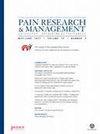Efficacy of Acupuncture Combined with Patient-Controlled Analgesia in the Treatment of Acute Pain after Back Surgery: A Meta-Analysis
IF 2.5
3区 医学
Q2 CLINICAL NEUROLOGY
引用次数: 0
Abstract
Objectives. Acupuncture is used worldwide to relieve both acute and chronic pain. Patient-controlled analgesia (PCA) is also frequently used for postoperative pain relief. However, there are few meta-analyses of the efficacy of acupuncture with PCA in reducing acute postoperative pain. This meta-analysis aimed to assess the effectiveness of acupuncture with PCA in relieving acute pain after back surgery. Methods. We searched seven databases (Cochrane Library, Web of Science, PubMed, China National Knowledge Infrastructure (CNKI), Wanfang database, Chongqing VIP (VIP), and Chinese BioMedical Literature Database (CBM)-from 1949 until now) without language restrictions for randomized controlled trials, including patients undergoing back surgery and receiving PCA alone or treated with acupuncture/sham acupuncture + PCA for pain relief. This meta-analysis assessed pain intensity, with visual analogue scale (VAS) score and postoperative opioid dosage as primary outcomes. Results. A total of 12 randomized controlled trials (n = 904) met the inclusion criteria. Compared with the control group (standard mean difference (SMD) = ‒0.42, 95% CI = ‒0.60 to ‒0.25, P < 0.01 ) or sham acupuncture + PCA (SMD = ‒0.7, 95% CI = ‒0.94 to ‒0.46, P < 0.01 ), acupuncture + PCA treatment reduced the VAS score in patients after back surgery. Acupuncture + PCA decreased the use of opioids after surgery compared to sham acupuncture + PCA (SMD = −0.35, 95% CI = ‒0.63 to ‒0.07, P = 0.01 ) or control group (SMD = ‒0.82, 95% CI = ‒1.03 to ‒0.61, P < 0.01 ). Furthermore, the use of acupuncture with PCA reduced the incidence of postoperative PCA-related total complications (odds ratio = 0.44, 95% CI = 0.23 to 0.85, P = 0.01 ), but may not reduce the incidence of postoperative nausea and vomiting (odds ratio =0.82 , 95% CI =0.49 to 1.36, P = 0.44 ). Conclusion. This systematic review found that acupuncture with PCA relieved acute pain after back surgery more effectively than PCA alone and could reduce opioid use and the incidence of postoperative PCA-related total complications针刺联合患者自主镇痛治疗背部手术后急性疼痛的疗效:一项meta分析
目标。针灸在世界范围内被用于缓解急性和慢性疼痛。患者自控镇痛(PCA)也常用于术后疼痛缓解。然而,很少有关于针灸配合PCA减轻术后急性疼痛的meta分析。本荟萃分析旨在评估针刺配合PCA缓解背部手术后急性疼痛的有效性。方法。我们检索了七个数据库(Cochrane Library, Web of Science, PubMed,中国知网(CNKI),万方数据库,重庆VIP (VIP)和中国生物医学文献数据库(CBM)-从1949年至今),没有语言限制,用于随机对照试验,包括接受背部手术并单独接受PCA或针灸/假针灸+ PCA治疗的疼痛缓解患者。该荟萃分析评估疼痛强度,以视觉模拟评分(VAS)评分和术后阿片类药物剂量作为主要结果。结果。共有12项随机对照试验(n = 904)符合纳入标准。与对照组(SMD = -0.42, 95% CI = -0.60 ~ -0.25, P < 0.01)或假针+ PCA组(SMD = -0.7, 95% CI = -0.94 ~ -0.46, P < 0.01)相比,针刺+ PCA治疗降低了背部手术后患者的VAS评分。与假针+ PCA组(SMD = - 0.35, 95% CI = -0.63 ~ -0.07, P = 0.01)或对照组(SMD = -0.82, 95% CI = -1.03 ~ -0.61, P < 0.01)相比,针刺+ PCA组术后阿片类药物使用减少。此外,针刺合并PCA降低了术后PCA相关总并发症的发生率(优势比= 0.44,95% CI = 0.23 ~ 0.85, P = 0.01),但可能不会降低术后恶心和呕吐的发生率(优势比=0.82,95% CI =0.49 ~ 1.36, P = 0.44)。结论。本系统综述发现,针灸联合PCA比单独PCA更有效地缓解背部手术后急性疼痛,并可减少阿片类药物的使用和术后PCA相关总并发症的发生率
本文章由计算机程序翻译,如有差异,请以英文原文为准。
求助全文
约1分钟内获得全文
求助全文
来源期刊

Pain Research & Management
CLINICAL NEUROLOGY-
CiteScore
5.30
自引率
0.00%
发文量
109
审稿时长
>12 weeks
期刊介绍:
Pain Research and Management is a peer-reviewed, Open Access journal that publishes original research articles, review articles, and clinical studies in all areas of pain management.
The most recent Impact Factor for Pain Research and Management is 1.685 according to the 2015 Journal Citation Reports released by Thomson Reuters in 2016.
 求助内容:
求助内容: 应助结果提醒方式:
应助结果提醒方式:


